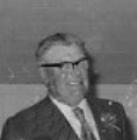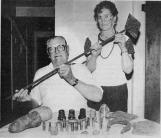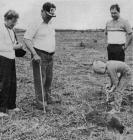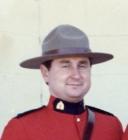1
The search for the site of the Humboldt Telegraph Station was intricantly linked to the lives of August Faul and Larry McLeod.3
The interesting times of the Humboldt Telegraph Station had long passed, when landowner August Faul rekindled the interest in the historic site.August Faul's father, Josef, took out a patent on the land SW-16-37-23-W2nd in 1907 and the land has been in the family ever since.
Mr. Faul related that as a boy growing up he heard many stories about the artifacts and gun trenches, dating back to 1885, found on the land, and other interesting things that led him to believe the original telegraph station was located on his land. Most of the land was a pasture until 1953 when it was first broke. Working the land had brought many artifacts to the surface that should not have been there if the land was previously unoccupied.
Information from the Wednesday, August 26, 1987 edition of The Humboldt Journal.
5
Mr. Faul suspected that he had found the original building site or one of its outbuildings located in the middle of the quarter in 1963, when he uncovered a stack of 150 tin survey plates and rods under a few inches of dirt in a depression where a building once stood.The plates were identified as those used by federal land surveyor A.C. Talbot who was in the area in October 1883.
Near the plates were many glass insulators dating back to the 1870's. These were screw type and pressure fitted types similar to those used on the original telegraph line, indicating the presence of some type of telegraph facility in the area.
Many other broken household artifacts have been collected in the area on the surface, including a broken clay pipe and bottle pieces.
Information from the Wednesday, August 26, 1987 edition of The Humboldt Journal.
7
In 1987, Corp. Larry McLeod went over the knoll with a metal detector and unearthed hundreds of metal artifacts including old beef bully tins that were the rations of the military forces.He suspected that it must have been General Middleton because of the massive number of old tin food containers and the number and type of rifle cartridges found.
"The proximity to the Carlton Trail, which is just a few feet southwest of the southwest corner of the quarter; the fact that the Prince Albert Trail passes through the southwest corner of quarter; the telegraph line passing through it at one time; plus all the evidence recently collected are too much to be overlooked," said Corp. McLeod and Mr. Faul.
"The clincher," said Mr. Faul, "is a photograph of a military encampment next to a slough. The slough and land are similar to a section of my quarter."
Information from the Wednesday, August 26, 1987 edition of The Humboldt Journal.
9
Larry McLeod, an RCMP officer posted in Humboldt, helped fuel the search for the station."I come by my interest in Saskatchewan history honestly. My great grandfather, Jerome Henry, was a Metis teamster for General Middleton and may very well have hauled supplies over the Carlton Trail at the time of the Rebellion. He supplied Riel and Dumont with sketches of Middleton's encampments. This is documented in several books and research papers on the Rebellion.
My grandfather, William M. Grant came to what was then the North West Territories in the mid 1880's. He became a prominent businessman, started the Model Farm on the Victoria Plains near Regina, was a farming instructor at the Provincial Jail and went on to win the seat of Batoche, under the Liberal Banner, in the Province's first election. He and several brothers started the Grant Brothers stores. Shortly after the rebellion they owned the store at Batoche that had belonged to Old Man Batoche, as well as one at Fish Creek and one at Prince Albert.
Donald Grant, William's older brother married Mrs. Grundy, wife of Post Master Grundy who was killed in the fight at Kinistino with Almighty Voice.
My interest in Western Canadian History is deeply rooted and has spawned my interest in the Telegraph sites at Humboldt."
(Information from "Historic Humboldt" written by Larry McLeod.)
Larry and his wife were killed in a car accident in late 2000.
10
Military supplies found at the site of the original Humboldt Telegraph Station.1987
Humboldt, Saskatchewan, Canada
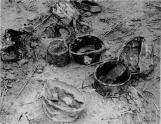
11
Dr. John Hart, adult basic education instructor at Carlton Trail Regional College and history lecturer at St. Peter's College in Muenster, is one of the few experts on Western Canada history in the province.After visiting the site with Corp. McLeod, Dr. Hart felt that the original telegraph site had been found.
He drew his conclusion from four facts: the presence of the surveyors, second location to the Carlton Trail, the presence of General Middleton and the widening military presence leading to the rebellion.
"Humboldt was the last telegraph (station) before the rebellion. It was crucial for communications. The Canadian government depended on the station for information about the rebellion."
Dr. Hart said the role of the station was important in determining Western Canadian history after 1885 since it was at the fork of the historical road leading to the frontier and later to agriculture settlement that followed after the rebellion.
Information from the Monday, September 21, 1987 edition of The Humboldt Journal.
13
"The key is that McLeod and Faul get merit and recognition they deserve for the fact that they got something going and it did not benefit themselves in the process. I believe they were right. I don't have definite proof, but I believe they are right and their research is going to open up this significant area," said the historian.Corp. McLeod said he is pleased his work has generated so much interest in the subject and is excited it may lead to a major dig.
(Information from the Monday, September 21, 1987 edition of The Humboldt Journal.)
August Faul sold this land to his neice, Joan Hergott, and her husband, Harold.
